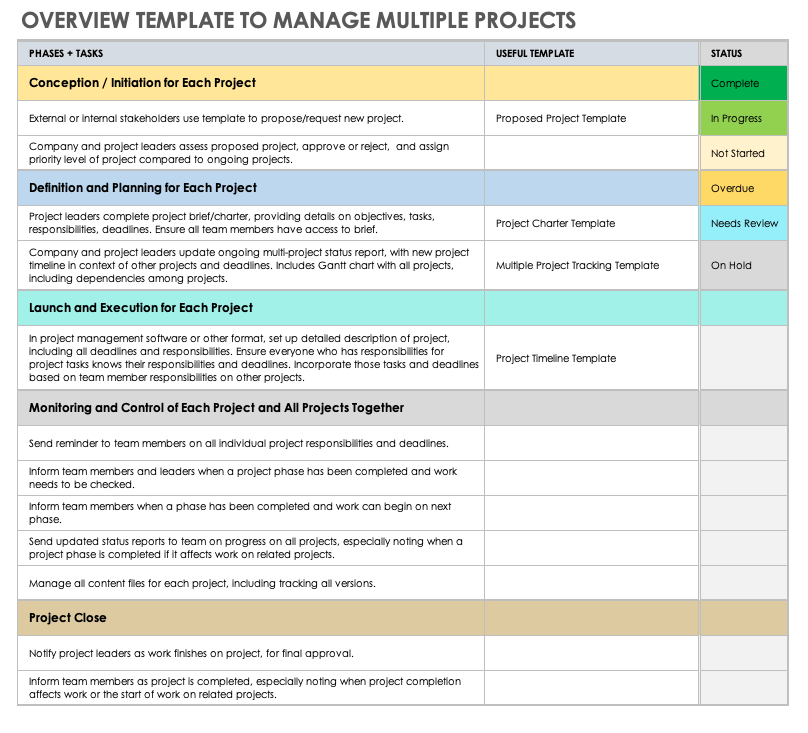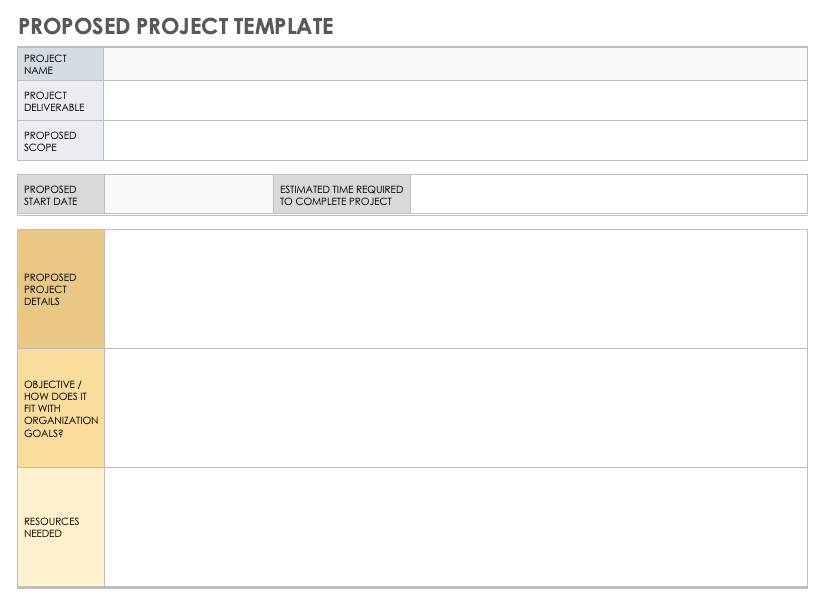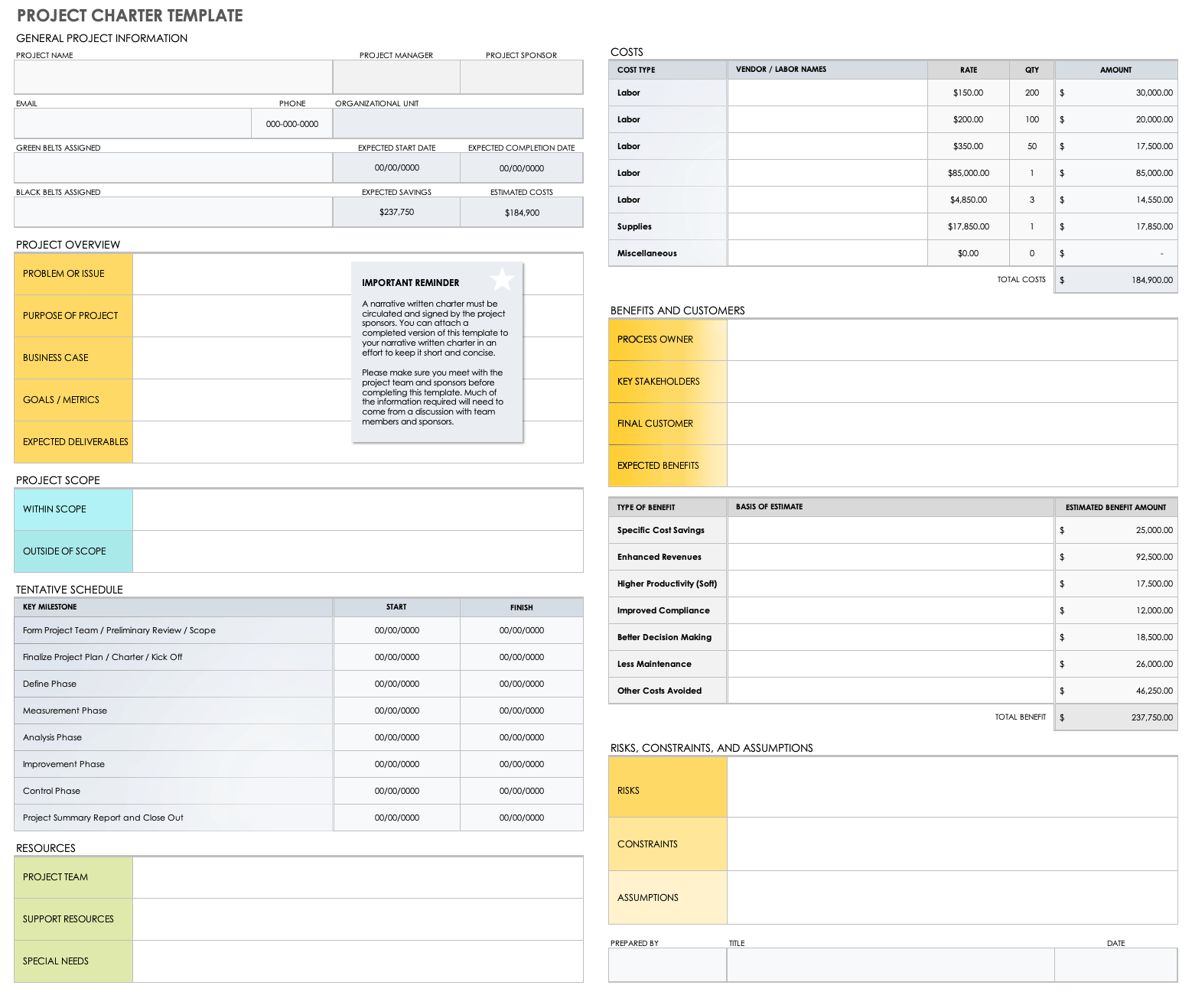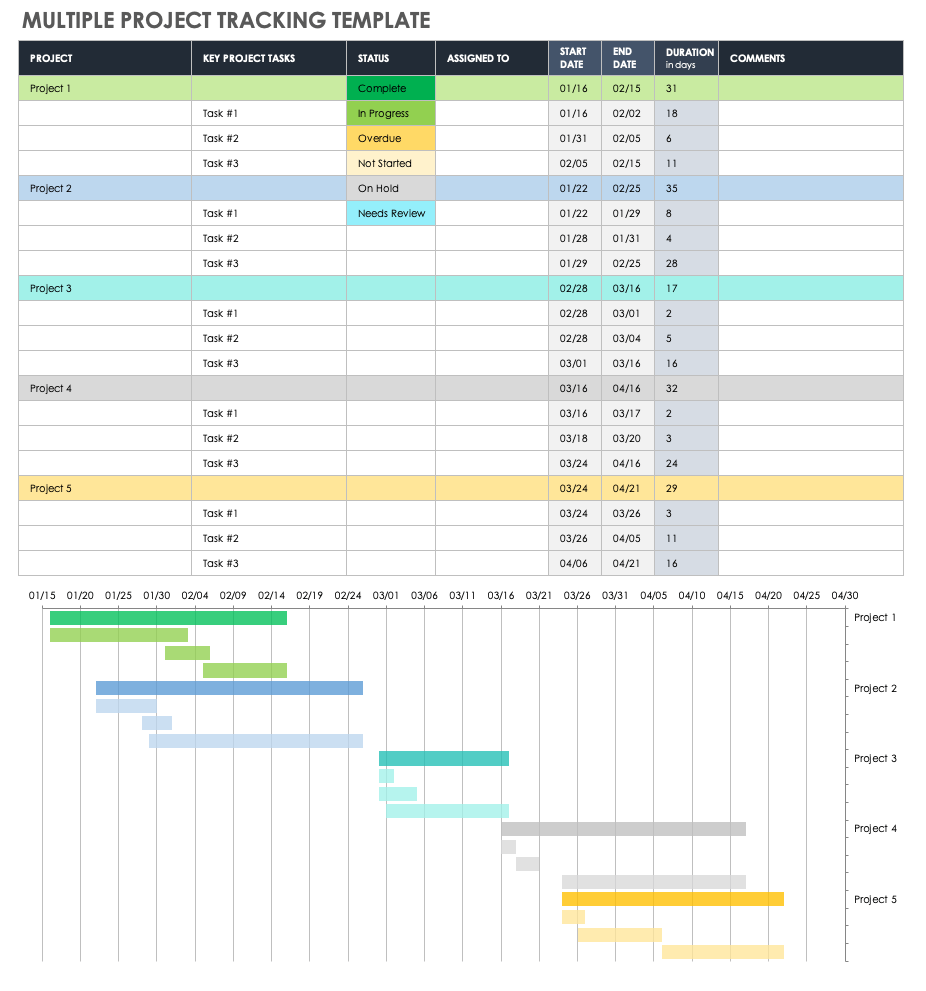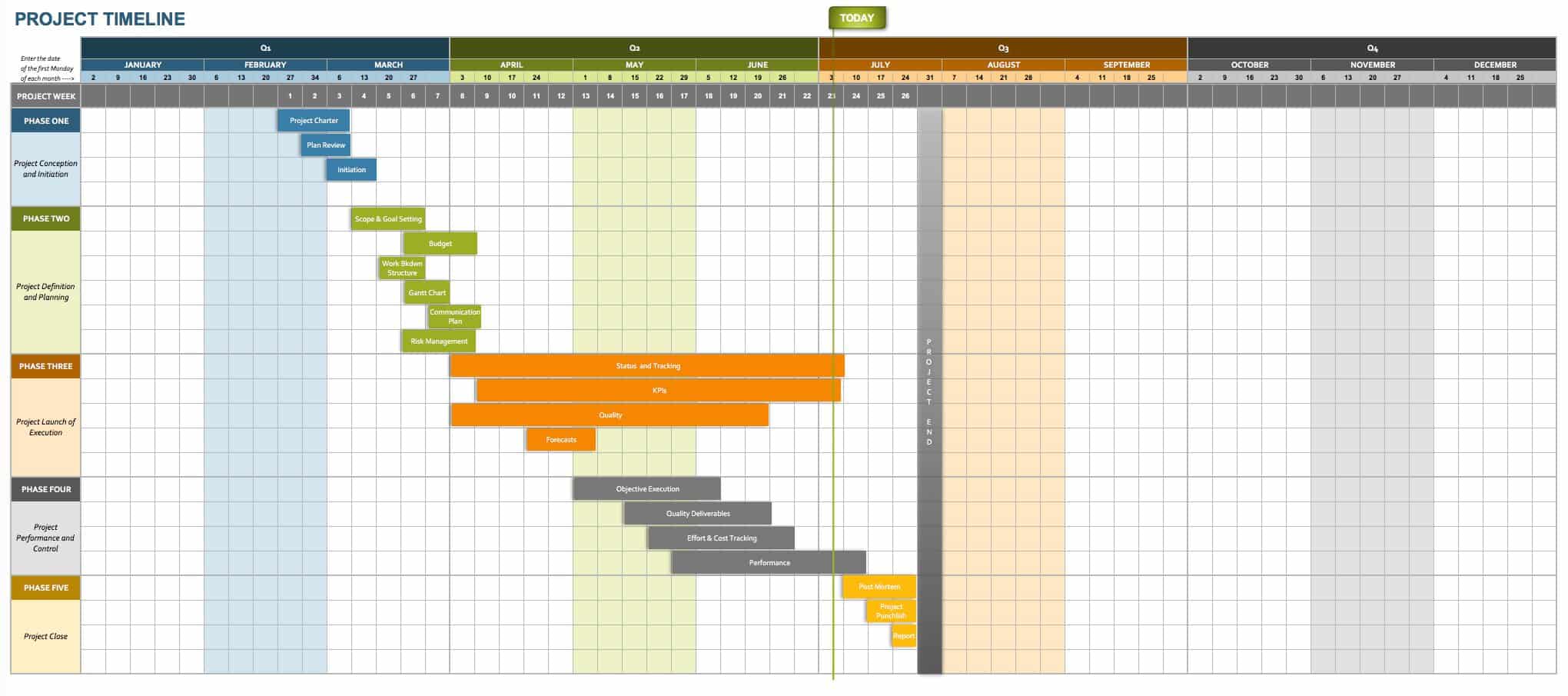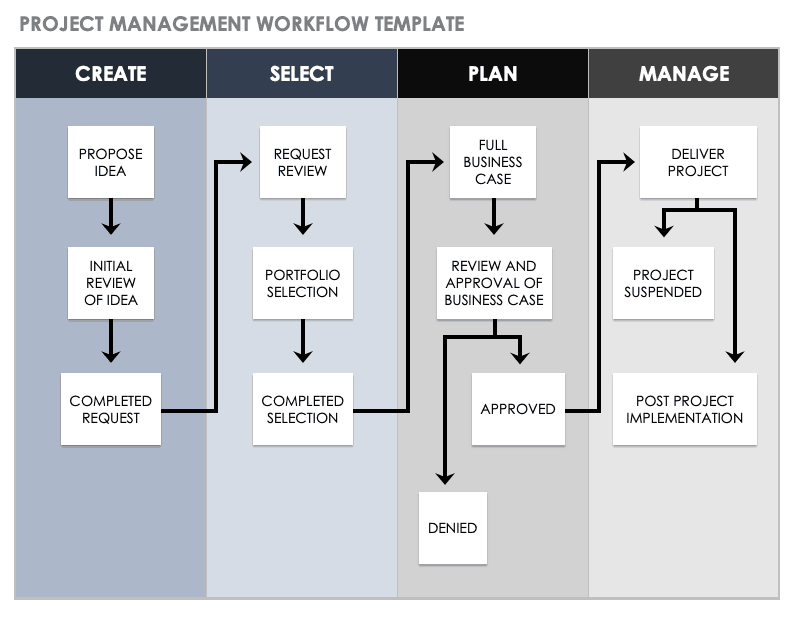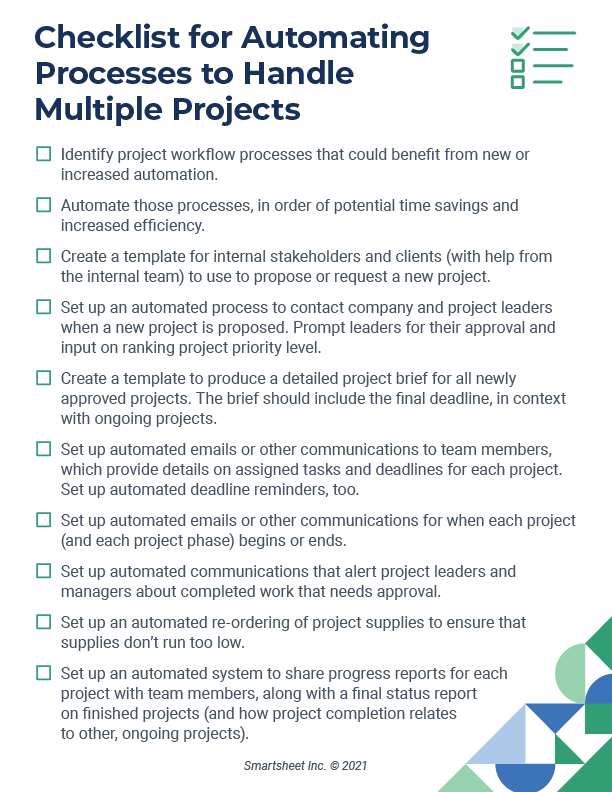Multiple Project Management vs. Program Management
Whereas program management is more concerned with an organization’s overall strategic goals, managing multiple projects requires you to focus on specific deliverables and deadlines, as you would when managing a single project.
Therefore, while managing multiple projects can seem to fall under the category of program management, the two concepts are distinct.
| Characteristics | Multiple Projects Management | Program Management |
|---|---|---|
| Scope | Each project has its own defined and limited objectives. | The program has a broader scope related to the organization's overall mission and goals. |
| Planning | Project managers define the objectives and how to accomplish them. | Program managers develop an overall program and set out an organizational vision for program work. |
| How to Define Success | Each project includes specific deliverables that the team completes against predetermined deadlines. | The team assesses the program’s overall benefit to the organization. |
| Lifecycle | Temporary. | Permanent and ongoing. |
Project and Portfolio Management E-book
Feel like work is moving faster than ever? It is.

In this introduction to project and portfolio management (PPM), learn how to streamline your efforts and get multiple projects — or an entire portfolio — over the finish line, on time and on budget.
How to Manage Multiple Projects
You must have a strategy to manage multiple projects at once, and doing so well requires that you continually assess priorities and juggle tasks.
Here are some guidelines for managing multiple projects:
- Plan Ahead: Managers and project managers face a typical problem: spending too much time on one task. Anticipate the time you need to complete existing tasks before committing to new projects. Then, create a comprehensive project scope and schedule tasks accordingly. If you don’t, you may find yourself jumping from one project to the next, not knowing which tasks to complete next to stay on track.
- Evaluate Project Tasks: Separate project tasks by the due date and organize them by sub-categories (daily, weekly, and monthly). Follow a process for targeting each task based on the category and project deadline so you can handle them all effectively throughout the project schedule and avoid bottlenecks.
Below are some tips for dealing with a large volume of tasks:- Color code tasks by level of importance.
- Complete at least one actionable item on your task list every day. This doesn’t have to be a huge task, but it should be something you finished that day.
- List (and accomplish) smaller tasks in order to help make larger goals feel manageable. Track these tasks to create a personal sense of accomplishment that you can report during progress updates.
- Prioritize Outcomes: No matter how organized you are, managing multiple projects can be challenging if you don’t prioritize tasks based on the desired outcomes. Enlist your team to help set up a system to identify and track priorities.
Before you stop working on a task, ask yourself what will happen to a project if you don’t complete it on schedule. Consider how each project aligns to larger company goals. Then, identify the work that will have the most impact.
Below are some important things to keep in mind when working on multiple projects:- Resist chipping away at the easiest projects first. Instead, prioritize work based on what will have the largest impact.
- Check in with team members regularly to see which tasks need to be completed before a project can progress to the next task.
- Set Expectations: Before you begin work on any project, manage expectations by gaining a clear understanding of the project’s objectives and the ideal (but realistic) deadline. If you can’t accomplish the objectives by the original deadline, talk to project leaders and make adjustments.
Tips for Managing Multiple Projects
Experts stress that managing multiple projects requires you to continually track goals, employ excellent communication skills, and learn to tell people when you can’t take on additional work.
Here are some additional tips for managing multiple projects:
- Avoid Multitasking: To effectively manage and finish multiple projects on time, avoid changing tasks frequently. Instead, give your full attention to a single task for a defined period of time (at least 45 to 60 minutes). Set a timer and stick with the work until the timer rings. If possible, extend the defined period on one task.
When you change tasks often, you’re less productive. Your brain needs time to adjust to each change before it’s productively working on a new task. - Establish a Solid Process Structure: Kristen Jourdanis, Senior Technical Product Manager at Airspace, a California shipping and logistics firm, offers the following advice: “Establishing a common language and a consistent high-level process is most important. If I can’t communicate effectively across the team, no one understands what I’m talking about, and the outcome will not meet the project’s intended purpose. If no one knows what should be happening across the project, they won’t provide critical input when something may be off course. I try to set up an autonomous system under which team members are empowered to report their progress in an automated fashion.”
- Commit to Communication: Strong communication is key to ensuring that everything runs smoothly. With so much daily work and many projects, it’s easy to lose sight of or neglect an important task. Create an organization system that clarifies project priorities without the need to over-communicate and micromanage your team. Then, focus on communicating what’s essential for success.
- Say No: You won’t be able to move multiple projects forward effectively if you say “yes” to any and all new work. Other people may want to regularly assign you new tasks, and you must be able to say “no” to anything you can’t realistically take on — otherwise, existing tasks will suffer, as you’ll miss deadlines, produce sub-par work, or both.
“The most significant constraint [to managing multiple projects well] is not having enough hours in the day,” says Harrin of Otobos Consultants. “This is both a resource management issue and portfolio prioritization issue, as bosses expect individuals to say yes to every new initiative. There isn’t the willingness to have an honest conversation about the realistic likelihood of getting all the projects delivered successfully.” - Avoid Distractions: In today’s work environments, there are many distractions — emails, Slack messages, phone texts, meetings, and phone or Zoom calls. You must avoid these distractions for a defined period of time in order to make progress on project tasks and goals. Set a timer and mute email, text, and other notifications.
For other helpful tips on ways to focus and manage time effectively, read our guide to time management tips and techniques. - Keep Your Team and Yourself Accountable: Schedule regular check-ins with your team (some may be one-on-one meetings). You’ll also want to schedule team-wide meetings or smaller-group get-togethers where people can discuss progress or issues they are having, as well as report on what they plan to accomplish in the upcoming week (or other defined work period). The project manager should also report on tasks and any issues.
“Have regular check-ins and build relationships with your team,” Harrin says. “You mainly want them to feel that they can tell you about challenges or upcoming time off work so you can develop your schedules. I teach people to use a consolidated calendar that shows the key milestones and essential points in each project across all their projects, so they always keep the big picture in mind.” - Develop a Signal for Business: Provide signals to co-workers when you can’t be bothered during certain times — except for real emergencies. That might mean the following:
- A physical sign on your door or workspace stating you can’t be disturbed for a certain period
- An email auto-reply that you won’t respond to non-emergency emails until a specific time
- Blocked out time on your calendar
- Always Recheck Goals: Jourdonais, from Airspace, recommends that teams “set a frequent baseline for the intended value of the projects and to see if the projects are tracking to deliver that value. I’m used to working in companies where the markets we operate in are evolving incredibly quickly. The intent of a project often does not always line up with the projected outcomes, due to volatile business factors. I keep close track of when things might be straying from the intended path. Sometimes this is OK, and we realize we need to change course and shuffle our priorities.
“It’s challenging to keep on top of it all, but I err on the side of over-communication and documentation about how these shifts are happening, so no one feels like they don’t understand where we are with each project today.” - Delegate Tasks: It can be difficult to pass off work to others, but sometimes, doing so is essential — especially for managers — in order to complete all the important work on time.
Delegating work can actually be the most efficient use of everyone’s time. If you’re not the manager, make sure a manager approves all possible transfers of work. - Manage Expectations: As your project moves forward, continue to communicate with project leaders about any hurdles you experience in completing certain tasks, or any other issues. Help them understand why certain project objectives or deadlines may need to change long before the deadline approaches.
- Always Understand Upcoming Tasks: Thomas Cagley is the President of Tom Cagley and Associates, a consulting firm that helps companies with software development and maintenance. “Having a single backlog of tasks is critical, “ he says. “The backlog needs to provide an overall view of work to be prioritized and drawn into whatever work management systems are being used.”
Strategies and Methodologies to Manage Multiple Projects
Experts recommend a range of project management strategies and methodologies to manage multiple projects simultaneously. In order to implement some of these strategies and methodologies, you can use the following basic tools:
- Gantt Chart: A Gantt chart is a timeline view of a project that tracks tasks, as well as resources, dependencies among tasks, and overall project progression. (To learn more about Gantt charts and download free Gantt chart templates, visit “Free Gantt Chart Templates for Multiple Projects.”)
- PERT Chart: This type of chart provides a sequenced, graphical view of all scheduled tasks in a project,as well as projections of the shortest, longest, and most likely lengths of time needed to finish a project, along with most likely project length. (Read our guide on PERT charts and to find templates.)
- Fishbone/Ishikawa Diagrams: Used for root cause analysis, this type of diagram looks like the skeleton of a fish. Note the problem you’re analyzing at the head of the fish, and any possible causes as fins out from the spine. (To learn more about fishbone diagrams and other Lean techniques, visit “The Indispensable Guide to Lean Process Improvement with Templates and Case Studies.”)
- Work Breakdown Structure (WBS): This visual tool helps you define and track all of the small components and deliverables that make up a project. (Read our WBS guide to learn more.)
Here are some important strategies and methodologies that can help you manage multiple projects simultaneously:
- Waterfall: This is the most traditional project tracking methodology, in which team members map out a project in sequential phases. Doing so often allows you to see how subsequent phases can begin only after a previous one ends. (Read our tutorial on Waterfall to learn how to create these charts to learn more.)
- Agile: This method is based on iterative development, and began as a strategy for software development. Work and solutions evolve as collaborative teams constantly work on a trial and error basis to adjust and improve processes. (You can learn more about Agile by visiting “Everything You Need to Know about Agile Project Management.”)
- Scrum: One of the most common Agile methodologies, Scrum is a bit more structured than pure Agile. Scrum provides a way for teams to think about how something might work best, and then continually test and improve it. (Read our guide to Scrum methodology to learn more.)
- Sprints: In Agile projects, sprints are iterations of specific work that a team completes in a fixed time period. Sprints usually last about two weeks, and never longer than a month. Each Sprint focuses on finishing a specific task from the product backlog, which is the list of tasks that must be completed.
Airspace’s Jourdonais says she may use a hybrid of the more traditional Waterfall and Agile on some projects.
“It’s hard to get company-wide buy-in to the core tenants of many of the flavors of Agile with required deadlines that are in place with some projects,” Jourdonais says. “I tend to work backward from a deadline in a Waterfall fashion, with chunks of intended work in each two-week sprint. Then, in a sort of Agile fashion, I re-baseline and update the project as we learn in each sprint how feasible the deadline is. You start to learn quickly which projects have real deadlines as you discover your trajectory in each sprint timeframe and make adjustments.” - Kanban: This is a coordination technique, often used in manufacturing and production, in which teams use small Kanban cards to represent tasks. Team members move these cards across a Kanban board that has different columns, which represent the stages of the manufacturing or project process.
- Scrumban: This project management methodology combines features of Scrum and Kanban. It combines the structure of Scrum with the increased team flexibility in Kanban.“I use a Scrumban approach to internal projects,” says Thomas Cagley. “Work is prioritized, refined, and then drawn into work-in-progress as capacity is available.”
- Scaled Agile Framework (SAFe): This is a methodology that uses the Agile framework but works better for larger organizations.
- Critical Path Method: Use this method to identify the sequence of tasks a team must complete to finish a project. It shows the longest possible duration of the project, which provides insights into the project schedule. (To learn more about this practice, visit “The Ultimate Guide to the Critical Path Method.”)
- Critical Chain, or Critical Chain Project Management: Critical chain is similar to critical path, but it takes greater account of an organization’s resources in forecasting the time it will take to complete a project.
- Rational Unified Process (RUP): This is a process that originated at a division of IBM, under which you divide software development or project work into four phases: inception, elaboration, construction, and transition.
- Four-Square Method: In this method, users create a list of tasks and then choose which of four squares the tasks fit: important, non-important, urgent, not urgent. Team members then perform the work based on those choices.
Starter Kit for Managing Multiple Projects Simultaneously
This starter kit includes an overview template to help your team track multiple projects at once, as well as templates to aid in that process. Specifically, you’ll find templates to propose a project, create a project charter, track multiple projects at the same time, including track details, responsibilities, and deadlines for each project.
Download Starter Kit for Managing Multiple Projects
Overview Template to Manage Multiple Projects
Download Overview Template to Manage Multiple Projects - Microsoft Excel
Your team can use this template to help them track and manage multiple projects at once. The template includes entries to help tracking throughout the process. It also includes details on and links to other templates that can be useful to track multiple projects. You can customize the template to fit your needs.
Proposed Project Template
Download Proposed Project Template
Use this template to propose a project and offer details on the proposed project, including methodology. This template includes entries for details on the proposed project, how the proposal fits with organization goals, and a proposed start date. You can customize it to fit your needs.
Project Charter Template
Download Project Charter Template
Microsoft Excel | Microsoft Word | Smartsheet
Your team can use this project charter template to create a charter for your project. The template allows you to provide details on the project and on its scope, schedule and costs. Your team can customize the template to fit your needs.
Multiple Project Tracking Template
Download Multiple Project Tracking Template
Use this template to track multiple projects simultaneously. The template includes space to enter details about multiple projects and tasks within those projects. It also allows your team to track various deadlines on a Gantt chart, so you can see how deadlines on various tasks and projects align with each other.
Project Timeline Template
Download Project Timeline Template
Your team can use this project timeline template to provide a detailed description of a project, including all team member responsibilities and deadlines. You can incorporate these tasks and deadlines based on team member responsibilities on other projects, and customize the template to fit your needs.
Challenges in Managing Multiple Projects
It’s easy to feel overwhelmed when working on multiple projects, as it can be challenging to keep track of everything, coordinate work in the best way, and communicate effectively.
Here are some of the most common challenges of managing multiple projects:
- Lack of Visibility across All of Your Projects: It can be hard to see and assess in one place all of the work and overall goals for every project.
“If you can’t imagine the work, managing it becomes very difficult,” says Cagley. - Inconsistencies in Deliverables and Processes: Some projects are managed differently or through a myriad of different systems, which can introduce inefficiencies if deliverables and processes are inconsistent.
- Uncertainty in Prioritizing Tasks: With so many tasks and so many projects, it can be challenging for team leaders or members to prioritize the most important tasks at any one time.
- Duplicate Work: If your team doesn’t coordinate its work well, team members may end up unknowingly working on the same task.
- Missing or Losing Information: When you don’t track the basics on each project, your team can miss information that is vital to completing a project.
- Poor Communication Across the Team: When working on multiple projects simultaneously, you may experience communication breakdowns and, as a result, inefficiencies.
- Ineffective Resource Allocation: When you’re tracking and coordinating all work and all project objectives poorly, you can use too many resources for some tasks and not enough on others.
- Teamwork Hindered When Working Remotely: Team leaders and team members have learned that solid work can be done remotely. But, collaboration is still sometimes more effective when team members can meet in person, at least periodically.
“With remote work … efficient collaboration can be a big challenge across tooling platforms and time zones,” Jourdanis says. “I always prefer to sit in a room with stakeholders to steer projects. It’s hard to read a room and gain intuition on more nuanced factors when there is no room, as you can’t always see if the participants are engaged or listening. It’s difficult to know how to reach everyone effectively."
Workflow Automation for Multiple Project Management
Automating workflow can be helpful in all project management, but it’s especially true in managing multiple projects. You can automate repetitive tasks such as approvals, updates, and reminders. Technology can free up time for team members to tackle more complex work.
Your team might consider low-code or no-code software to manage multiple projects. The platforms provide a graphical user interface that helps in programming simple solutions for your team without needing to hand-code anything. Examples of such software include Visual LANSA, GeneXus, Creatio, and Smartsheet.
You can learn more about these tools by reading our guide to workflow automation.
Project Management Workflow Template
Download Project Management Workflow Template
Microsoft Excel | Microsoft Word | Adobe PDF
Templates can help you figure out and track proper workflow when managing multiple projects. This free, downloadable template is useful for developing new project plans, creating steps, and securing stakeholder approval.
Find additional free project management workflow templates for specific projects.
How To Automate Workflows for Multiple Projects
You can automate some of your team’s workflow to help move forward multiple projects at the same time. You can learn more by downloading this helpful checklist, which includes prompts for how to successfully introduce automation to multiple projects.
Download Checklist for Automating Processes to Handle Multiple Projects — Adobe PDF
Managing Multiple Projects With Project Management Software
Managing multiple projects can be overwhelming without project management software, which offers a range of tools that can help you better manage multiple projects at the same time.
Project management software can help you do the following:
- Gather all documents, notes, and messaging about a project into one platform. The platform also generally provides a quick summary of the status of tasks in a project and the overall status.
- Schedule tasks and subtasks in a real-time calendar that all team members can see.
- Create daily or weekly reports that provide an overview of individual and team progress.
- Create automated to-do lists.
- Create tracking reports on available resources and resource management.
Streamline Multiple Project Management with Smartsheet
Empower your people to go above and beyond with a flexible platform designed to match the needs of your team — and adapt as those needs change. The Smartsheet platform makes it easy to plan, capture, manage, and report on work from anywhere, helping your team be more effective and get more done. Report on key metrics and get real-time visibility into work as it happens with roll-up reports, dashboards, and automated workflows built to keep your team connected and informed. When teams have clarity into the work getting done, there’s no telling how much more they can accomplish in the same amount of time. Try Smartsheet for free, today.

